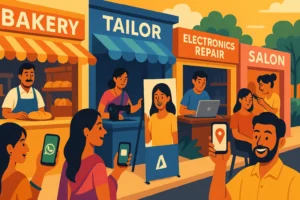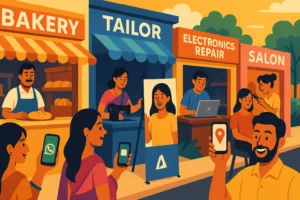India is fast emerging as a powerhouse in lithium ion battery (LIB) manufacturing. With surging demand, aggressive policy support, and major investments by industry giants, the country is well on its way to becoming the world’s largest exporter of lithium ion batteries — potentially within this decade.
But we must be understand that there is a difference between lithium battery and lithium ion battery.
You may also like to read:The prospect of lithium ion battery growth in india.
✅ Difference Between Lithium Battery and Lithium-Ion Battery
Although the terms “lithium battery” and “lithium-ion battery” are often used interchangeably, they refer to different technologies:
| Feature | Lithium Battery (Primary Cell) | Lithium-Ion Battery (Rechargeable) |
|---|---|---|
| Rechargeable | ❌ No (Single-use, disposable) | ✅ Yes (Rechargeable hundreds of cycles) |
| Use Case | Small electronics like watches, cameras, pacemakers | Electric vehicles (EVs), energy storage, laptops, mobile phones |
| Chemistry | Metallic lithium as anode | Lithium compounds in a liquid electrolyte |
| Cost | Low for small cells | Higher due to complex design and recyclability |
| Lifecycle | One-time use | Long lifecycle (500–3000 cycles) |
📈 1. Explosive Domestic Demand: A Strong Launchpad for lithium ion batteries market.
India’s LIB demand is projected to leap from 10.8 GWh in 2022 to 160.3 GWh by 2030 The Australian+3Saur Energy+3IEEFA+3WRI India+1IMARC Group+1. This growth is driven by:
- A booming EV market expected to hit 10 million annual sales by 2030.
- A growing need for stationary energy storage to support renewable expansion, with estimates calling for 336 GWh of capacity by 2030 Financial Times.
🏛️ 2. Policy Support: Enabling the Ecosystem
India’s PLI scheme for Advanced Chemistry Cells (ACC), with an outlay of ₹18,100 crore, aims to catalyze 50 GWh of domestic cell manufacturing capacity ETN Mail+5Saur Energy+5Autocar Professional+5. Complementary measures include:
- Full customs duty exemptions for lithium and cobalt imports Reuters+7Saur Energy+7Stocks Mantra+7.
- Leadership confidence, with Nitin Gadkari stating that India could become the top LIB exporter within five years Reuters+11Autocar Professional+11WRI India+11.
🏭 3. Manufacturing Capacity: Scaling Fast
From a modest 18 GWh cell capacity in 2023, India is targeting 150 GWh by 2030, representing exponential growth Reddit+7WRI India+7IMARC Group+7. Notable gigafactory developments include:
- Amara Raja Energy & Mobility in Telangana: 16 GWh cells + 5 GWh pack capacity by FY 2029 IEEFA+7Stocks Mantra+7Wikipedia+7.
- Exide Industries in Bengaluru: Phase‑1 6 GWh cell factory going commercial in FY 2025, expanding later globenewswire.com+5ETN Mail+5timesofindia.indiatimes.com+5.
- Ola Electric in Tamil Nadu: scooter-cell manufacturing already underway, full cell output expected by 2025 Autocar Professional+2ETN Mail+2Stocks Mantra+2.
- Reliance’s Jamnagar Green Energy Giga Complex: scaling from 5 GWh now to 50 GWh by 2027 and 100 GWh by 2030 Wikipedia.
- JSW‑LG, Tata (Agratas) and IBC, Cygni Energy, and others launching big-ticket battery gigas Stocks Mantra.
🔋 4. LFP Focus & Material Security
India is championing Lithium Iron Phosphate (LFP) chemistry for its lower cost structure, excellent thermal stability, and suitability to Indian conditions Saur Energy+1Reddit+1.
Alongside cell-making, materials manufacturing is gaining momentum:
- Altmin Private Limited plans India’s first LFP cathode giga‑factory (initial 8 GWh, scaling to ~100 GWh by 2030) ETN MailReddit.
- The discovery of 5.9 million tonnes of lithium in Jammu & Kashmir, and overseas partnerships (e.g. SQM stake in Australia) under a ₹14,800 crore critical minerals mission IMARC Group.
🌍 5. Why India Could Lead the Exports Game
- Cost edge: Cell manufacturing costs in India (~US $93/kWh) are projected to stay lower than China or Korea IEEFA.
- Surplus capacity: With 150 GWh of cell output but domestic demand of ~160 GWh by 2030, exportable volume is realistic.
- Diversifying players: Export-driven strategies by Exide (expanding exports beyond current ~8%) and others timesofindia.indiatimes.com+1timesofindia.indiatimes.com+1.
- Growing global demand for affordable energy storage and EV batteries, especially in emerging markets that favor LFP economics.
⚠️ Challenges on the Road Ahead
- Raw materials: India still imports most lithium, cobalt, nickel; supply volatility and geopolitics remain concerns.
- Technology gaps: Domestic production of CAM/AAM, BMS, separators is nascent—vertical integration is needed WRI India.
- Recycling infrastructure: Critical for sustainability and resource recovery; still early-stage development.
✅ Conclusion: Export Leadership by 2030?
India is positioning itself as a formidable player in global battery exports. With aggressive policy backing, rapid factory build‑out, deepening domestic ecosystem, and emerging raw material strategies, India’s chance to lead the lithium battery export market by the late 2020s is stronger than ever.
India’s entire manufacturing push under the PLI Scheme for Advanced Chemistry Cells (ACC) and gigafactory development is focused on lithium-ion batteries, not disposable lithium batteries.
Reasons why India’s export prospects are higher for lithium-ion batteries:
✔ Huge global demand for EV batteries and energy storage systems.
✔ Gigafactory investments (Amara Raja, Ola Electric, Reliance, Exide) are for Li-ion cells and packs.
✔ India plans 150 GWh annual LIB capacity by 2030 → surplus capacity for exports.
✔ Lithium-ion batteries are high-value products compared to small lithium cells.
✅ Conclusion
India’s export future lies in lithium-ion batteries, not simple lithium batteries. By 2030, India could be a major supplier of rechargeable LIBs for EVs and renewable energy storage markets globally.





